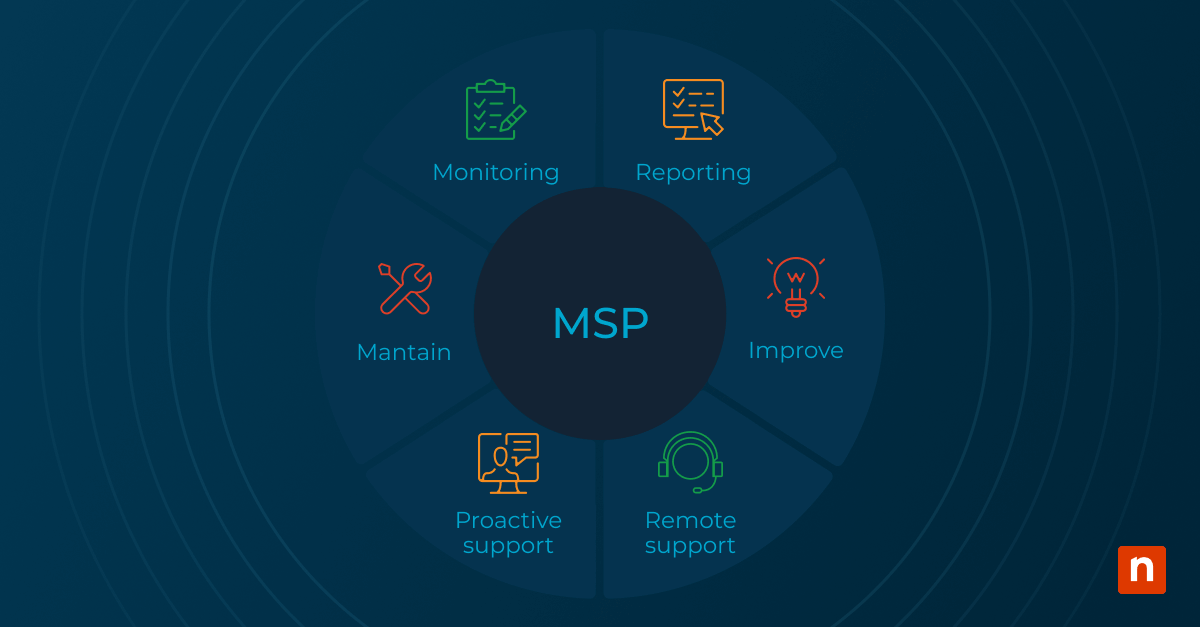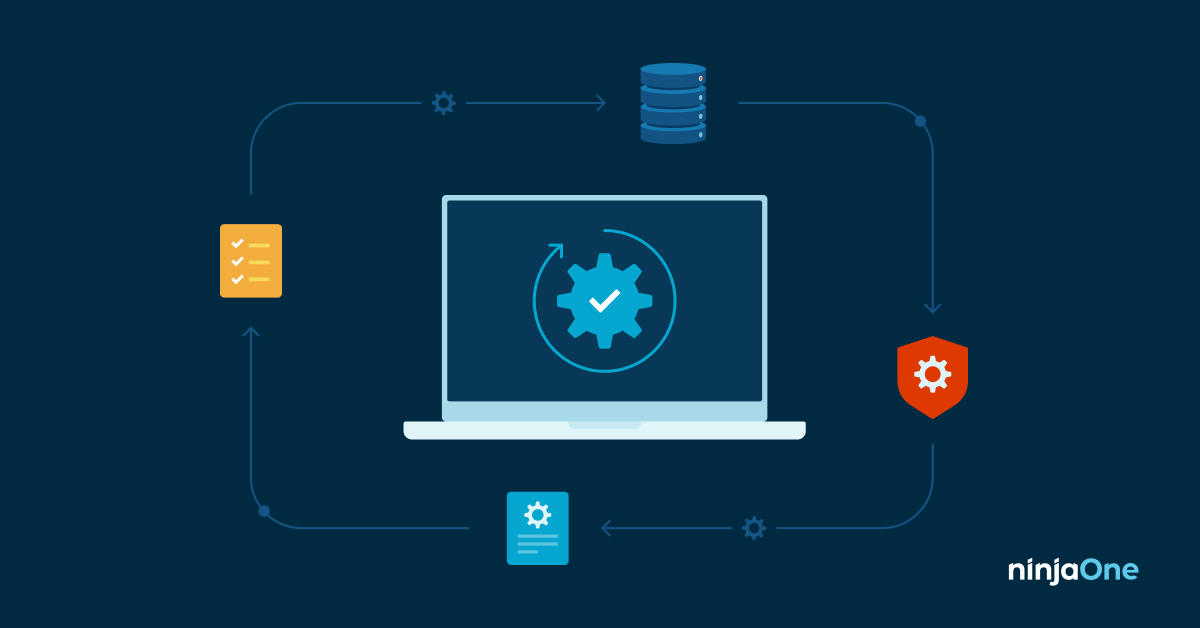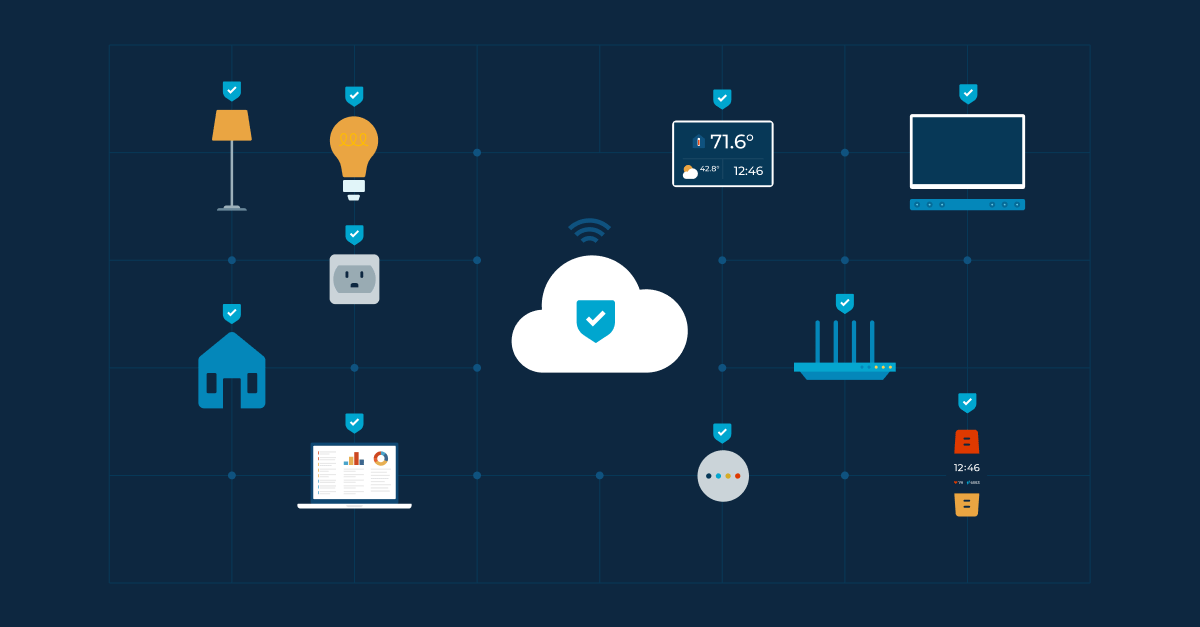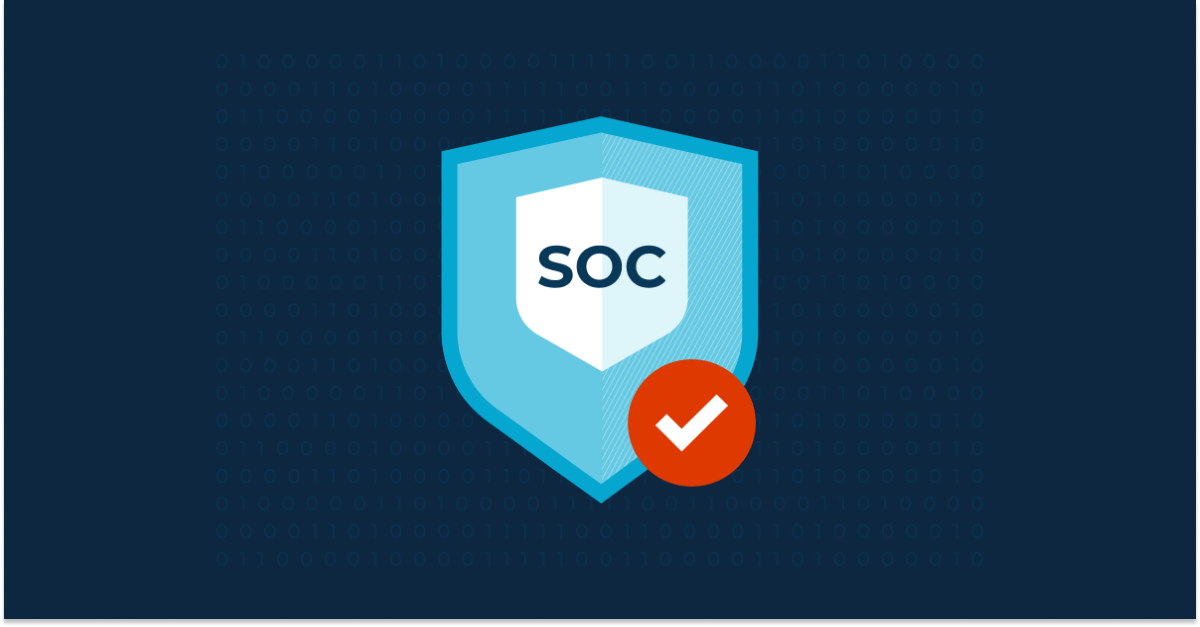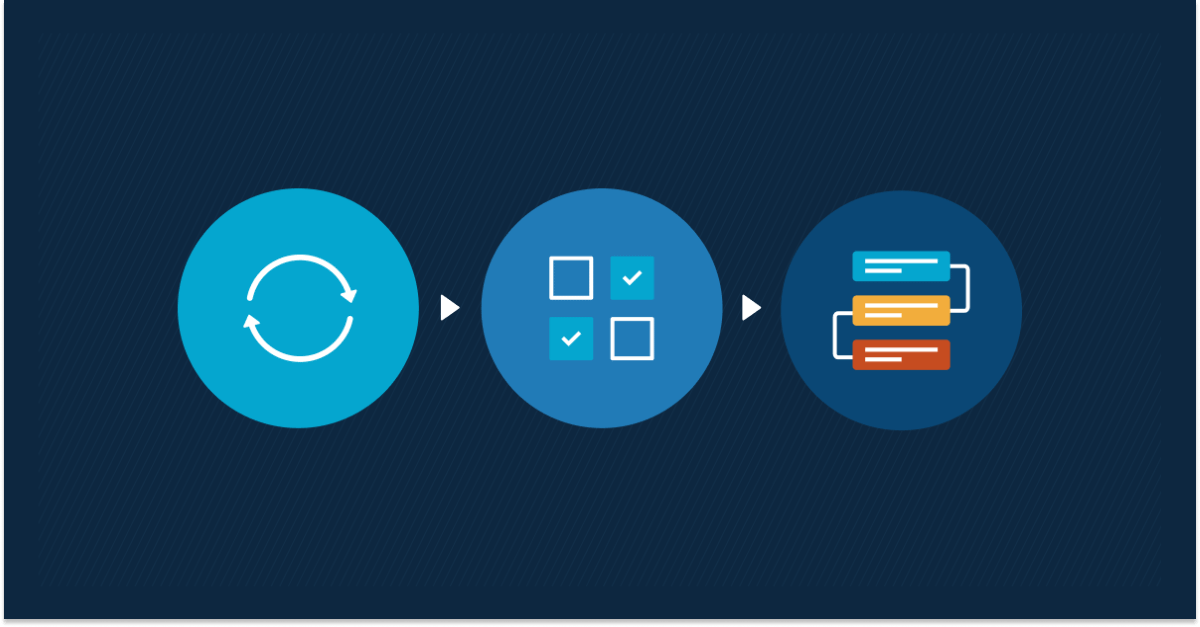Tom talks with OITVOIP CEO and MSP owner Ray Orsini about breaking points, developing culture and accountability, using fun as your North Star, and putting your team in a position to succeed without you.
One of the most defining things that sets the MSP space apart is its extremely tight-knit community, and few are more active and invested in giving back to that community than Ray Orsini.
After years of building a successful MSP business, he shifted his focus to launching OITVOIP and helping other MSPs succeed. These days, he can be found dispensing thoughtful, hard-earned advice (and ‘salute’s ?) on any of the ever-growing number of MSP community forums or any of his ever-growing number of video series, including The Tech Bar and Technical Deficit.
In this episode of MSP Breakthrough, NinjaOne Channel Chief Advisor and former MSP owner Tom Watson caught up with Ray to discuss the following and more:
- As an owner, reaching a critical breaking point early on
- Turning new hires into subject matter experts and creating a culture of accountability
- Putting your staff in a position to succeed without you
- Developing a “master process”
- Breaking up with bad clients
- Becoming an MSP vendor
- Breaking past growth plateaus at $500K, $1M, and $5M ARR
- Your #1 responsibility as an owner
Listen
Like the show? Please consider supporting it with a review. We’re just getting this sucker off the ground and that will help a lot!
You can review/subscribe at either of the following:
Watch
Read (transcript)
Announcer: This is “MSP Breakthrough,” where successful MSP owners walk us through the pivotal moments that put them over the top.
Jonathan: Hey, everybody. I’m Jonathan Crowe, Director of Content and Community at NinjaOne. I’ve got with me, as always, Tom Watson, our Channel Chief Advisor. Tom, who did you talk to this week for MSP Breakthrough?
Tom: I spoke to Ray Orsini, CEO of OITVoIP and also a long-time MSP owner.
Jonathan: Ray is very well known in the community. He’s a great guy. He’s got that unique perspective of being an owner and on the vendor side, too. What’s something that jumped out to you from your conversation?
Tom: In particular, Ray is really focused on process for his organization. He has a lot of processes, including their own knowledge base that they have built, which has many of the answers to problems, and he gets employees to really buy into that process. And it perpetuates through his organization, and it’s really led to how successful he has been.
Jonathan: Documentation is a huge challenge. Everyone who’s listening, you’re gonna get a lot from Ray’s takeaways there. Also, I know he’s got a ton of really great stories. So, I’m looking forward to this one.
As an owner, reaching a critical breaking point early
Ray: So, early on, much like almost every MSP I talk to, I started off a solo shop, right? I worked by myself and I had some clients, or I had some people that identified as, you know, they wanted to pay me monthly. I wanted to collect monthly. It was a “yay” for everybody. And that was, you know, the beginnings of the MSP for me.
And I was doing it all, right? I was handling the accounts, I was going out and doing the tech, the field service visits, setting stuff up. And it was great for, you know, a handful of months. It was awesome. I could handle everything. And then much like every MSP I talk to, those clients referred me to other clients, and it started to become a little bit much. And I realized, “Okay, so, this works really well, and I can handle these guys,” but I was getting to that breaking point of, okay, well, the administrative side of the house was falling behind. The account management stuff was falling behind, because I was just always chasing fires, right? I was chasing service requests, support requests. Projects were getting behind.
“I had this moment where I said, ‘You know what? Before I make another move, let me sit down and write it all out. What do I want? What do I want in a year? What do I want in two years? What do I want in five years?'”
And I was fortunate enough, really early on — and when I say early on, I mean, six months in — I realized I can’t do it all. I had this moment where I said, “You know what? Before I make another move, let me sit down and write it all out. What do I want? What do I want in a year? What do I want in two years? What do I want in five years? What do I want, myself? What do I want me to be doing in that timeframe?”
And I said, “Okay, well, I wanna focus on sales. I wanna focus on projects. I wanna focus on the fun stuff.” But, you know, we’ve all heard the adage, if you do what you love, you’ll never work a day in your life. Warren Buffett just talked about this the other day. He’s been doing this for 40-plus years, and he just does what he loves. And that’s what I wanted to do. That’s the genuine truth.
So, I figured early on I needed help. And I hired my first employee well before I probably was ready to, financially. But I did so because once I wrote down the plan, it was set in stone for me.
And I said, “Hell or high water, that’s what I’m going to effect — that plan.” And that plan started with somebody serving in the tech department. And that really worked out well, because it taught me a lot of things, and it let me focus on what I wanted to do. And I was able to improve relationships with the clients and focus on account management and decide projects I wanted to do. And it really freed me up as an MSP to do what I wanted to do.
Turning new hires into subject matter experts and creating a culture of accountability
Tom: Now, did you find, when you started hiring people, that you kinda had to have a different level of expectation?
Ray: So, I’ve been fortunate enough…I come from a background of entrepreneurship. My parents have had a real estate company for almost 50 years at this point. You know, I’ve owned multiple businesses before this one. So, I learned early on it’s all about networking. It’s all about relationships.
My early hires, I approached the same way I did my early sales. If I’m getting referrals for sales from one client to another, I’m going to use my networking contacts to determine who I was going to hire. And that’s exactly how I did it. I was looking more for passion. I was looking more for attitude. Soft service skills. Because I knew I could teach the tech to anybody. I wasn’t really worried about that. I found somebody I liked from my networking circles, and I said, “Let’s bring you on.” I brought on a young guy. He was 18 at the time I brought him on, and he worked out really great for several years.
Tom: That’s great. That’s probably the earliest breakthrough I’ve heard in doing these interviews with MSP owners. That’s a pretty fantastic one. And it makes me think back to my days, and I remember the first person I hired because I just couldn’t keep up with the work. But I also had to kind of change my expectation of what people produce, because it wasn’t always exactly the same way I would have done it.
Ray: Right.
Tom: I had to institute a lot of process to try to get them as close to how I would do it as possible, but I know that’s kind of a stumbling block, because I know a lot of our audience out there is looking at making that first hire. And maybe you could spend another minute or two telling us, you know – that’s a great way you looked at it, but what’s the most important thing when you decide that you’re gonna step away a little bit from that tech work and you’re gonna get other people, what do you think the most important thing they need to do is?
Ray: So, it’s what you’re talking about. It’s the process, the documentation. I’ve spoken on process and documentation probably a billion times. Probably as many times as you have, and I realized early on…and I had the benefit of… I came from the Miami Police Department where you imagine they had a document for everything. They had an SOP, they had a policy and procedure for absolutely everything. And so, when I went to hire and when I was doing my business planning and all that stuff, I realized I’m super OCD. I’m a perfectionist at heart. I need to have things done to an exact precise result, and, you know, I’m all about the path to get there. So, I realized if I’m gonna hand this off to anyone, especially somebody newer in the industry, right, a young guy, I’m gonna have this documented on how I want things done.
I was already prepared to train, because I came from a background of mentorship and apprenticeship. I was in Big Brothers Big Sisters as a junior. I had my mentor and I came up in the industry like that. So, I was prepared to do that, but I knew that wasn’t gonna scale my one-on-one time with anyone. So, from the moment I did my business plan and I decided to hire someone to the first day that I hired them, everything I did, every ticket I worked, became a document. And then when I hired them, then it became, “I’m gonna teach you to do these things, but whatever I teach you, you’re going to create the documents.” You know, and then fast forward, you know, almost 10 years later, we have almost 8,200 documents in our KB. And that was the very beginnings of that. And we kept those processes ever since.
“Whereas if you say… ‘I’m gonna teach you. You’re going to document this. You’re going to teach the next person.’ Accountability becomes ingrained in that process.”
Tom: I think that’s a great point of having them create their own documents. Having them be a part of creating those processes, having some ownership over it.
Ray: Yeah. It creates subject matter experts. It creates new experts when you do this. You know, you have people that you’ll sit there and you’ll talk to, and you’ll explain, and they’ll say, “Yeah, yeah, yeah,” and then you’re finished, and they haven’t comprehended what you said. And they’re definitely not able to make it malleable and use it for the next thing that comes up that’s kinda in the same vein.
Whereas if you say, “I’m going to teach and we can record it and whatever. And that’s not a big deal, but I’m gonna teach you, you’re going to document this. You’re going to teach the next person.” The accountability becomes ingrained in that process. Their level of investment becomes raised, because they know now they’re accountable for doing this and they’re going to teach the next person.
And once you add to the mixture, saying, “Your peers in your department are going to learn from what you create. That’s going to be the support you have, or they’re always going to be asking you for help because you didn’t document it properly.” Once they get the bigger picture on that, they really go all-in on it, and they become awesome at creating documentation. And we require that of everybody in the company, regardless of department.
The importance — and difficulty — of putting your staff in a position to succeed without you
Tom: That’s great. So, that’s an excellent initial breakthrough to discuss. Do you have another one that comes to mind immediately?
Ray: Absolutely. So, you know, I’m fortunate that I do a lot of networking, I do a lot of talking with colleagues and learning from other MSPs and others in the industry. And the recurring theme I heard from everybody was, “I can never take a break. I can never take a vacation. I wanna take my family here. I wanna do this, and I can’t. It’s all me.” And even if you have an employee, they’re always overwhelmed. So, I realized I needed to take myself out of the equation, and that goes along with the documentation and the training, but anything that could happen, I needed to be able to train somebody to do it so I wasn’t necessary to it.
And that’s kinda…it sucks to say it as an owner. You know, it sucks to say as a principal, a company, a founder, but the goal for any of us should be, “Can this continue to operate if I wasn’t here?” Remove that bus factor, right? And that’s another theme that’s helped throughout the entire lifetime of the company — making sure that it’ll continue to operate and to operate at the same level of service that I would do myself. Repeatability, right?
It’s the Disney process. No matter…you meet 20, 200, 2,000 people in a day — they’re going to get the exact same response every single time. We applied that to the company. It’s worked really well.
Tom: Ray, I think that’s a good one, and it reminds me of my experience with having to let go and trust others in my company. I believe it was 2008, and I hadn’t been on a vacation in years. It was in my eighth year as an MSP owner, and I decided to go on this Italy trip with a group of young professionals. And in anticipation of that, I had my admin upgrade my Verizon cell phone, my Blackberry to the World Edition, you know, because…
Ray: So that you could be reachable.
Tom: Well, so that you can put, you know, one of their SIM cards. And so, I get to Italy. I’m in Rome at the airport, and I’m standing in front of the Vodafone store, and I need to go in there and get a SIM card so I can get it all working. And I stood in front for like 10 minutes, and then I just took the phone, and I put it back in my bag. I got to the hotel. I called my manager at the office, and I said, “Hey, listen, I’m not gonna activate my phone here.”
Ray: That’s great. I love that.
Tom: I said, “You guys gotta take care of this.” I said, “I’m gonna check in with you.” I said, “I’ll check my email twice a day, you know, in the morning at the hotel, and then when we get back to the hotel in the evening, but you gotta figure it out.” And it was one of the smartest decisions I ever made because it forced them to become responsible and accountable for things, and it really worked. But, yeah, it’s one of my favorite stories to tell. And I hadn’t thought about it in years until you brought up what you were talking about.
“At one point, I realized, ‘Trust my staff. Either I trained them right or I’m gonna come back, it’s all gonna be on fire, and we’re gonna have lessons…and we’ll be better going forward. But trust the process.'”
Ray: It’s hard, though, right? It’s hard to let go. It’s hard to say, you know…it’s hard to truly disconnect. It’s easy to sit there and monitor…and I’m guilty of it. I mean, even with knowing early on what I wanted to do in the process and trusting, I still…you know, I got married in 2011. And I still did the same thing you did. I took my laptop. I took my cell phone. We went out for a two-week cruise, and I’m thinking… I look back at now, and I think, “I’m an idiot. There’s no need for it.”
Now, I’ve learned since. I’ve forced myself to disconnect. I forced myself to start, you know, putting myself in positions where I couldn’t check on them if I wanted to. And some of the opportunities we got to do that, Lord knows I miss them, but the conferences, right? It’s really hard to multitask when you’re going and networking in the conferences, and the hallways, and the sessions. And, you know, even after hours and you’re doing the dinners and the vendor presentations, you cannot sit there and be on the phone. You know, if you’re sitting there on your laptop in the hallway, you’re not doing what you went to the conference to do, right? And we would do that. At one point, I realized, “Trust my staff. Either I trained them right or I’m gonna come back, it’s all gonna be on fire, and we’re gonna have lessons that we need to account for, and we’ll be better going forward, but, you know, trust the process.”
Tom: You know, Ray, I found that that trip — I got back and they…you know, the on-call people, when I stepped away, they didn’t need me as much. It was kind of like I kind of coddled them a little bit too much before that. And that one vacation — it was like 10 days I was there — it completely changed the business. And I look at it as a part of allowing it to scale, actually, because I had more bandwidth for the things I wanted to do. As you talked about, having the time to focus in on what you wanna do in the business is usually the things that are going to make it profit the most too. And I wanted to focus on…I mean, as you know, I like to talk. That’s what I do for a living now. I mean, it’s kinda what you do for a living too.
Ray: Yeah, absolutely.
Tom: Right. You know, I’ve been out of the MSP world for a few years now, and I just do that, and that’s all I wanted to do in the MSP world. I just wanted to sell, and I just wanted to talk and do some high-level management. And it’s important — I think it’s a really good message to people listening — that you need to figure out what you’re good at in the business and what you like to do and find a way to carve out those things. And, as much as possible, hand off whatever else there is to other people.
Ray: Yeah. I’ve seen exactly that. You know, I’ve seen it myself where they need you as much because you’re available. And the minute you take that away, you realize what they’re capable of. And that’s important also as an owner or as a boss. Give them the opportunity to show you. You know what I mean? Don’t be there and say, “It’s trial by fire.” We do it all the time, but give them the opportunity to show you how they would handle it in your absence. And more often than not, they’ll surprise you. And you come back with a greater appreciation and, honestly, a better comfort level, right? You don’t have to panic anymore about saying, “Oh, you know, I need to check on things. I need to make sure things are going fine.” Once you have that comfort level that they can handle it without you, it’s so much better as a business owner. You get so much more peace of mind.
Developing a “master process” to tackle any issue or challenge
Tom: Now, Ray, you’re in a really interesting situation because you are not only an MSP owner, you’re a vendor because you resell VoIP services.
Ray: The evil “V” word, yeah
Tom: And I guess this question is, kind of, two-part. Are there breakthrough moments where, maybe your MSP at some point was stagnating? You couldn’t grow? You couldn’t scale more, and maybe there was a decision you made that kind of got you over that hump?
And also maybe we go into where that becomes the OITVoIP solution, too. I’m kinda interested for people to hear what happens in a business that allows it to get over those humps. What happens in a business that allows it to go into other new areas?
Ray: So, you know, I’m a big fan of saying nothing’s unique. No one’s a snowflake. My mother was wrong. I’m not special. The situations we come across, you can find recurring themes if you look at it properly, if you look at it through a certain lens. Same thing with projects. Same thing with problems that come in. When you’re determining root cause analysis, you see recurring themes in everything you do, and your troubleshooting methods are kinda always the same, right?
“I’m a big fan of saying nothing’s unique. No one’s a snowflake. My mother was wrong. I’m not special. The situations we come across, you can find recurring themes if you look at it properly.”
Like we do in troubleshooting…our first step in all troubleshooting is replicate the issue. We need to make sure we can experienced the same thing the customer was experiencing regardless of what cases. And when I say that, I say that because those humps and challenges we came across as an MSP and moving to VoIP and everything we do today and tomorrow, they’re all addressed the same way. Once you figure out the process, you can address anything that comes up if you have a good plan to do it.
Now, figuring out that plan, that’s a whole different story, but the plan for us has always been, we apply a process called APEC:
- assess
- plan
- execute
- communicate
In that order, every single time. And so, when I learned that or when I came up with it early on, we looked at it and said, “Okay, well…” Say we were having a pain at the beginning with simple, stupid stuff, right? Like patching. You know, patching with our RMM was challenging, and keeping track of it. And the data was never good. And so, we said, “Okay, well, what do we need to track? What are the current methods?”
Same thing when we go to the hiring process, right? You look at the same thing and you say, “Okay, well, we need to grow. How can we make the hiring process better?” And it always came out to the same thing. Assess where you’re going into, plan your course of action, get it done, and then communicate the results, because if you can’t communicate it’s pointless.
And we always looked at that and said, “How can we do it better?” at the end of everything. You know, perfection is a goal. It’s not a destination. At the end of everything is, “How can we do better?” And we do so today. I mean, I’ve hired way too many people, and we’re still hiring, you know, more and more. We have two positions open now. And even though we have a strict onboarding process, we still make it better.
And so, not being scared to make mistakes, not being upset when you don’t have a… and take it from being a perfectionist to not being scared to say, “This could have been done better if I did it again.” Sometimes getting over that little ego hump, which is probably the hardest of all of them, has allowed for the success that we have.
Breaking up with bad clients
Ray: You know, it was a challenge when I made the decision that we were going to go to client selection on the MSP side, right? We went through the whole per device, per user, and, honestly, in the beginning, I did what everybody does. We took on anybody. Anybody with a check or a credit card, we took them. And, you know, I realized I spent a lot of time chasing people for money and I spent a lot of time…too much time on the wrong clients. And so, we had that breakthrough moment of, “We need to pick and choose our clients.” And then it was an assess. “Who are the best clients? Who are the clients that we wanna do business with?” And that became our standard, right? At least 10 employees, at least in business over 5 years, preferably in a regulated business, but definitely a professional industry. And that became the baseline.
And when we said, “Okay, we’re gonna only do MSP, we’re not gonna do this RMM-only or monitoring only thing and patching. We’re not gonna do hourly. We’re gonna have a specific set of clients. We’re gonna say no to everybody that’s not that. If they’re not auto-pay, we’re not going to take them. We’re not gonna take checks at all. You know, we’re not gonna take mail-in checks. We’ll do ACH.” And when I did that, without exaggeration, it was painful, but it was earth-changing for the MSP.
“You know how frustrating it is when the MSP that you’re operating is going check-to-check, but you have people owe you $60K?”
I wrote a blog article. I’ll give you the PG version. It’s fu-pay-me money. We were in arrears close to $60K a month and waiting for people to pay.
And you know how frustrating it is when the MSP that you’re operating is going check-to-check, but you have people owe you $60K? You’re late-paying your vendors because you can’t collect? So, when we made this change of, we were going to take this type of client, we’re going to let these clients go (we helped them move off), and only do recurring payment going forward. Anybody that couldn’t do it, we were going to let them go. And it made us so much better. Our average time to collection now? We’re less than 2% outstanding after five days, which is ridiculous. And it was not because we’ve been doing it so long. That was an immediate change because of our processes. It worked really well, and I don’t think we would have lasted as long if we didn’t have those standards.
Tom: Ray, I think that’s great. I think we’re gonna need for the audience here to get the URL for that blog post if it’s still up somewhere.
Ray: Yeah, yeah.
Tom: It hearkens me back to my days…I think I’ve talked about it. I think you brought it up on one of the podcasts. What happened was I was running my MSP, chasing people for money when the Great Recession happened. At that time, people just wouldn’t pay you. I mean, the people that were already slow pay just wouldn’t pay, and I nearly went under from it. And that’s when I had to make…that’s when I learned managed services and contracts and all-in, all-inclusive. And it’s funny how we all come to these solutions on our own, because I really didn’t have any direction. I wasn’t plugged into the MSP community at that time. And let’s face it, back in 2008, 2009, managed services as they do it now, and as I’d learned to do it, it wasn’t as established.
Ray: No, not at all.
Tom: There were a couple players, but I had to do that. And I remember the painful calls and meetings with clients, having to tell them, “Hey, listen, I can’t do this with you anymore.” Breaking up. It was like breaking up, you know, with girlfriends.
Ray: That’s the worst part, right? To figure out how you’re going to have that conversation, that’s the worst part of it.
Tom: Some of these people I’d been with, you know, they’ve been with me from the beginning, and they reminded me of that. You had people saying, “Ray, I’ve been with you from the start.”
Ray: Yeah. I got the same thing. And you feel so bad, which is why I say, help them move off, but you have to have that conversation. Or as you say, “Look, I really appreciate you. It doesn’t escape me that you’ve been so loyal to me for this amount of time, and I hope you feel that I have been loyal to you, as well. But just like I would do anything necessary to help you succeed and move on in life to whatever your next step is, that’s what I’m asking you to do to help me. And for me to make that change, I have to establish these things. And if you wanna come with me on the ride, great, but if you can’t, I understand. We just can’t keep working together.”
It’s a tough conversation. It’s not you. It’s me. It’s hard, man. It is so hard.
The transition to becoming an MSP vendor
Tom: Now, Ray, what’s the breakthrough where you’re an MSP, and then somehow you pivot, and now you are a VoIP vendor?
Ray: So, you know, I’ve gone through all the steps and we always, very early on…because my background is in complex and distributed networking — so, a multi-city, multi-site, multi-continent — that’s my jam. I’ve been working with TELCO since the early 2000s. And because of that, I got in VoIP very, very early. And so, we did VoIP, ourselves, as an additional service, and I strongly recommend every MSP also get into VoIP. It’s great sticky revenue. But because of the networking, because of the community engagement, and because of my proficiency, I started working with other MSPs. At first, it was just answering other questions, and sometimes doing a little bit of consulting. And more and more, I was spending more time doing that, and, more importantly, I was having more fun doing it.
“I loved working with MSPs more than I loved working MSP…. The decision was,’What do we want to do? What’s going to be more fun? Let’s hyper-focus on that skill set.'”
I’ve always loved hanging out with MSPs. I’ve always loved being part of the community, and I’ve always loved being helpful to my MSP brethren. And at the same time, I was having challenges with the… I’m not gonna call anybody out, but the traditional VoIP vendors, or TELCO vendors, which were getting into the IT services game and maybe taking a little bit of that revenue from the MSP side. And I was hearing the gripes from others. And I went back to the whole Warren Buffet thing, right, or the whole, you know, do what you love. And that has to be priority one.
And I loved working with MSPs more than I loved working MSP, right? I loved talking with others that were experiencing the same issues and had the same requirements and just talking battle stories, right? War stories with other MSPs. And I realized, “Why don’t we just focus on that?” It’s no different than when we decided to stop doing monitoring-only packages or hourly packages. It’s no different. The decision was, “What do we want to do? What’s going to be more fun? Let’s hyper-focus on that skill set.” And that became, I want to focus on working with other MSPs, enabling them to do what I’ve done and teach them what I’ve done and create those programs.
And those partner programs I created for the channel partner and the white label stuff specifically out of my experience as MSP, but I knew to make that sea change, I couldn’t keep taking MSP clients. I couldn’t divert my focus. I had to pick one. And I picked the MSPs. I’m always gonna pick the MSPs. That’s never gonna change.
You know, I love what I do and who I work with. And so, I made that decision and had more of those, “It’s not you, it’s me” conversations with my clients. I did help them off. A lot of the MSPs that work with us, you know, got the benefit of i. I migrated my clients off from us to these other MSPs, but we decided in 2017 or late 2016, effected at 2017, that we were done in the MSP world. We still have a handful of customers that we service MSP today. They’ve been long-time, really good, really profitable, really easy customers, but all my business now are the VoIP stuff or the MSP clients.
Breaking past growth plateaus at $500K, $1M, and $5M ARR
Tom: Wow. Great. Just one more question for you. I know, Ray, you’ve had an MSP for a number of years, and I’m sure it’s a multi-million-dollar a year MSP. What I like to ask people is, is there a moment where you kind of…you often see this hurdle at around $600,000, $800,000, and then crossing that $1 million. Somewhere in there, maybe you could tell us of what those hurdles look like, and was there a breakthrough that allowed you to kinda break through that mark, and then, all of a sudden, you could scale a lot more?
Ray: Yeah, I think I’m with you. For us, it was the $500,000. That was the ledge that we teetered on for… it probably took us six months to get over it. You know, we broke $400,000 and then between $400,000 and $500,000, it took us a long time to break that $500,000 threshold. And then it just ramped up really, really quickly, and then the $1 million was the same thing. Breaking our first $1 million was really, really hard to do and the same thing with the $5 million mark.
And it’s funny, because you talk to other MSPs, and they have those same numbers, same numbers you’re saying — the $600,000, the $1 million — and I don’t know why it is. It’s just, you know…I really couldn’t tell you. Even to this day, I couldn’t tell you why those plateaus happen and those thresholds happen.
“Anytime we experienced a plateau, it’s, ‘Let’s re-examine what we’re doing’…. it’s the being willing to change that I think lets you get over those humps.”
I know, for us, it was anytime we experienced a plateau, it’s, “Let’s re-examine what we’re doing. Are we spending enough time?” We did the same thing this past year, right? We looked at it and said, “Okay, well, we wanted to have a knockout year, and we’ve been able to expand year-over-year by multiples.” It’s been fantastic, but this year we wanted to press even harder on conferences and on events.
We had, I think, 14 conferences planned for last year, at the beginning of the year. ITExpo is the last one we actually attended in-person. So, you know, it took all of us by surprise. But I still decided…or we, because I can’t take credit for anything. It’s a team effort. We decided we’re not gonna let it hold us back. So, the initiatives we had for the year, we sat there and said, “Okay, well, we’re gonna do a virtual conference, instead. We were going to do an in-person conference in 2021. We were going to host our own. Our partners have been asking for it for years. We decided, “You know what, we’re going to do a virtual conference. If that’s what we have, let’s speed it up, and let’s get that done.”
And just identifying the plateaus when they happen. You have to look at metrics. You have to look at your numbers. You have to look at your finances on a regular basis. None of it can catch you by surprise. You have to plan the time to look at these things, but when you see them, when you identify them, when you hit those plateaus and you say, “Okay, well, it’s been a month and we haven’t really made big changes the way we had the previous three months, or where we were expecting to be in 2020 Q4.” You have to be able to move quickly and change direction. And that’s what we did with the marketing efforts. We said, “Okay, well, if we can’t do the in-person stuff the way we want to, we’re going to put out a metric, you know, F-ton of webinars, and we’re gonna start a new podcast and…” You know, some of what you’re doing. So, ours is more drinking and having fun. You know The Tech Bar stuff. You know, just the craziness.
We’re going to participate in more communities. We’re going to just absolutely push digital as far as humanly possible if we can’t do it in-person. And then next year, you know, if we’re all fortunate enough to be able to do this in person next year, we’ll do the same thing in-person, and we’ll take what we learned from this year. But it’s the being willing to change that I think lets you get over those humps, because, if not, I don’t wanna sit there doing the same thing over and over again. That’s the definition of insanity, right?
Your #1 responsibility as an owner
Tom: Right. Well, that’s great. And I think we’re just about done here with this “MSP Breakthrough” episode, but I will say you touched on something that’s important, and it sounds like you’ve been really good at pivoting when necessary, and you talked about even this year pivoting. And as an experienced MSP owner and someone on the vendor side, when you’re looking at the situation where maybe a young startup MSP that maybe started this year, what would you say to them about what they need to really be aware of, how they need to maybe possibly pivot, maybe just some suggestions for them?
“Set the habits early. So that, when you do expand your team, it’s not new to you. You don’t want your staff figuring stuff out at the same time you are. You want to be prepared. That’s your job as a boss.”
Ray: So, it’s all a matter of applying APEC, right? The assesses, you know, look at where you are today, plan where you want to be tomorrow, and find a way to… if you already know where you want to get to, you should be able to carve those things out based on time. Carve them up based on quarters, based on years, whatever you want to do.
“How do I get there? What does that look like?” And then schedule time to sit there and evaluate it on a regular basis, right? We have finance meetings every week. We have tech meetings every week. I sit with every one of my departments every week. If you’re just starting out, it’s you, but you still have administration. You still have tech, you still have finance, you still have projects.
Set the time early, set the habits early, so that when you do expand your team, it’s not new to you. You don’t want your staff figuring stuff out at the same time you are. You want to be prepared. That’s your job as a boss. You need to be supportive of them. You know, they’re not always going to be able to teach you stuff, even though you should learn from them, but you want to be able to give them what’s going on. So, you need to be able to plan ahead of time. And when you can plan, then you can pivot. It’s easy enough.
Announcer: Thanks for listening to “MSP Breakthrough,” brought to you by NinjaOne. If you enjoyed this episode, please subscribe, like, or give us a review.
But wait, there’s more!
Thank you for checking out this episode and hope you enjoyed it. We’ve got a killer lineup of fantastic guests for future episodes, so make sure you don’t miss their breakthroughs by picking a subscribe option below:
If you liked this episode, please consider giving us a review. We’d love the feedback and really appreciate your support!
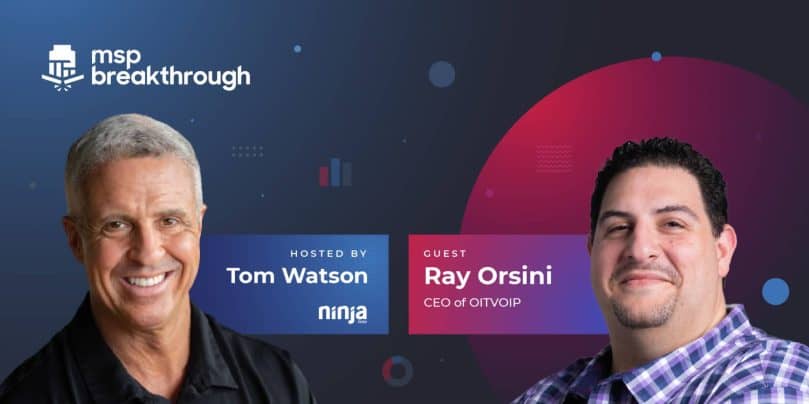
 “I had this moment where I said, ‘You know what? Before I make another move, let me sit down and write it all out. What do I want? What do I want in a year? What do I want in two years? What do I want in five years?'”
“I had this moment where I said, ‘You know what? Before I make another move, let me sit down and write it all out. What do I want? What do I want in a year? What do I want in two years? What do I want in five years?'”